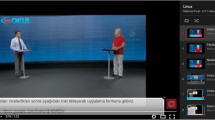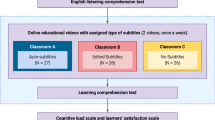Abstract
Learning through video is an important learning method at present. In various teaching videos, subtitle size varies greatly. Therefore, it is essential to evaluate the influence of subtitle size on different teaching videos. In this paper, 90 college students from a Chinese University were randomly divided into three groups: small subtitle teaching video group, middle subtitle teaching video group and large subtitle teaching video group. The experiment was conducted to explore the effect of subtitle size on learners’ cognitive load, academic performance, and learning satisfaction. The results showed that: (1) compared with the large subtitle teaching video, learners had lower cognitive load when watching small and medium subtitles teaching videos; (2) compared with the large subtitle teaching video, the learners who watched the small subtitle teaching video had better performance; (3) compared with the large subtitle teaching video, the learners who watched the small and medium subtitle teaching video had higher learning satisfaction. Based on these results, this paper emphasizes the importance of subtitle size in teaching video. We suggest that the relevant departments should further refine the production standards of teaching videos; teachers should try to make teaching videos with smaller subtitles; students should choose teaching videos with smaller subtitles; researchers and technical teams should strengthen the research and development of personalized subtitle technology, so as to allow the private customization of subtitle size based on learners’ needs and preferences.


Similar content being viewed by others
References
Ashtiani FT (2017) The effect of typographical features of subtitles on nonnative English viewers’ retention and recall of lyrics in English music videos. Int J Appl Linguist Engl Lit 6(7):122–129. https://doi.org/10.7575/aiac.ijalel.v.6n.7p.122
Bernard M, Liao CH, Mills M (2001) The effects of font type and size on the legibility and reading time of online text by older adults. In CHI'01 extended abstracts on human factors in computing systems (pp 175–176). https://doi.org/10.1145/634067.634173
Carmichael M, Reid A, Karpicke JD (2018) Assessing the impact of educational video on student engagement, critical thinking and learning.A SAGE white paper
Chen MP, Wang LC, Zou D, Lin SY, Xie H, Tsai CC (2020) Effects of captions and English proficiency on learning effectiveness, motivation, and attitude in augmented-reality-enhanced theme-based contextualized EFL learning. Comput Assist Lang Learn 5:1–31. https://doi.org/10.1080/09588221.2019.1704787
Choi HJ, Johnson SD (2005) The effect of context-based video instruction on learning and motivation in online courses. Am J Dist Educ 19(4):215–227. https://doi.org/10.1207/s15389286ajde1904_3
Crabb M, Jones R, Armstrong M, Hughes CJ (2015) Online news videos: the UX of subtitle position. In proceedings of the 17th international ACM SIGACCESS conference on computers & accessibility (pp 215–222). https://doi.org/10.1145/2700648.2809866
Cunyou W (2015) Investigation and reflection on the usefulness of captions in online teaching videos. China distance education,12, 61-66 + 80. [In Chinese]
Cunyou W (2016) Are subtitles necessary in online learning video? The modification of redundant effect. E-education Research, 37,75(03), 59–65. [In Chinese]
Cunyou W, Yan W, Wenjing C (2018) Instructional video design from the perspective of factors affecting the effect of autonomous learning. China Educ Inform 24:5–9 [in Chinese]
Department of higher education, Ministry of education. Technical standard for shooting and making quality video open class. IOP Publishing PhysicsWeb. http://old.moe.gov.cn//publicfiles/business/htmlfiles/moe/s6871/201302/147737.html.Accessed 07 October 2020
d'Ydewalle G, Van Rensbergen J, Pollet J (1987) Reading a message when the same message is available auditorily in another language: the case of subtitling. In eye movements from physiology to cognition (pp 313–321). Elsevier. https://doi.org/10.1016/B978-0-444-70113-8.50047-3
García B (2017) Bilingual subtitles for second-language acquisition and application to engineering education as learning pills. Comput Appl Eng Educ 25(3):468–479. https://doi.org/10.1002/cae.21814
Gengsheng X, Xiaoyun Y (2020) An experimental study on the influence of subtitle form on English audio-visual learning. Mod Educ Technol 30(04):81–87 [In Chinese]
Greco GM (2016) On accessibility as a human right, with an application to media accessibility. In Researching audio description (pp. 11–33). London: Palgrave Macmillan. https://doi.org/10.1057/978-1-137-56917-2_2
Ho CL, Dzeng RJ (2010) Construction safety training via e-learning: learning effectiveness and user satisfaction. Comput Educ 55(2):858–867. https://doi.org/10.1016/j.compedu.2010.03.017
Jamet E, Le Bohec O (2007) The effect of redundant text in multimedia instruction. Contemp Educ Psychol 32(4):588–598. https://doi.org/10.1016/j.cedpsych.2006.07.001
Jian W, Yinhua H, Jilong L (2014) Experimental research on the effect of teaching video presentation on Autonomous Learning. Audio Vis Educ Res 35(03):93–99 + 105. [In Chinese]
Jung Y, Lee J (2018) Learning engagement and persistence in massive open online courses (MOOCS). Comput Educ 122:9–22. https://doi.org/10.1016/j.compedu.2018.02.013
Kalyuga S (2012) Instructional benefits of spoken words: a review of cognitive load factors. Educ Res Rev 7(2):145–159. https://doi.org/10.1016/j.edurev.2011.12.002
Karakas A, Sariçoban A (2012) The impact of watching subtitled animated cartoons on incidental vocabulary learning of ELT students. Teach Engl Technol 12(4):3–15
Karamitroglou F (1998) A proposed set of subtitling standards in Europe. Transl J 2(2):1–15
Kirkland CE (1999) Evaluation of captioning features to inform development of digital television captioning capabilities. Am Ann Deaf 144:250–260. https://doi.org/10.1353/aad.2012.0140
Leveridge AN, Yang JC (2014) Learner perceptions of reliance on captions in EFL multimedia listening comprehension. Comput Assist Lang Learn 27(6):545–559. https://doi.org/10.1080/09588221.2013.776968
Li B (1997) How to configure subtitle color in TV program production. TV subtitles (special effects and animation), 02,23-26. [In Chinese]
Manchón LM, Orero P (2018) Usability tests for personalised subtitles. Transl Spaces 7(2):263–284. https://doi.org/10.1075/ts.18016.man
Mayer RE (2006) Multimedia learning. Translated by Yong, N., Xiang, Q. Commercial Press, Beijing
Mayer RE, Moreno R (2003) Nine ways to reduce cognitive load in multimedia learning. Educ Psychol 38(1):43–52. https://doi.org/10.1207/S15326985EP3801_6
Montagud M, Boronat F, Pastor J, Marfil D (2020) Web-based platform for a customizable and synchronized presentation of subtitles in single-and multi-screen scenarios. Multimed Tools Appl 79:21889–21923. https://doi.org/10.1007/s11042-020-08955-x
Montero Perez M (2019) Pre-learning vocabulary before viewing captioned video: an eye-tracking study. Lang Learn J 47(4):460–478. https://doi.org/10.1080/09571736.2019.1638623
Ni Z, Qingtang L, Jun L, Suxiao X, Lin Y, Lingling L (2021) Effects of collaborative lesson study on student satisfaction and academic performance. Research on Audio Visual Education 42(02):85–92
Ovharhe OJ, Emaziye P, Okwuokenye GF (2020) Farmers’ satisfaction with agricultural extension services in Delta State, Nigeria. Int J Agric Technol 16:1463–1474
Ozcelik E, Karakus T, Kursun E, Cagiltay K (2009) An eye-tracking study of how color coding affects multimedia learning. Comput Educ 53(2):445–453. https://doi.org/10.1016/j.compedu.2009.03.002
Paas FG, Van Merrienboer JJ, Adam JJ (1994) Measurement of cognitive load in instructional research. Percept Mot Skills 79(1):419–430. https://doi.org/10.2466/pms.1994.79.1.419
Pujadas G, Muñoz C (2019) Extensive viewing of captioned and subtitled TV series: a study of L2 vocabulary learning by adolescents. Lang Learn J 47(4):479–496. https://doi.org/10.1080/09571736.2019.1616806
Ritzhaupt AD, Pastore R, Davis R (2015) Effects of captions and time-compressed video on learner performance and satisfaction. Comput Hum Behav 45:222–227. https://doi.org/10.1016/j.chb.2014.12.020
Roshier AL, Foster N, Jones MA (2011) Veterinary students' usage and perception of video teaching resources. BMC Med Educ 11(1):1–13. https://doi.org/10.1186/1472-6920-11-1
Rudd RE (2007) Health literacy skills of U.S. adults. Am J Health Behav 31(Suppl 1):S8–S18
Shouju C, Yunfeng H (2007) Media art and design. Chongqing University Press, Chongqing, p p47 [In Chinese]
Shu H, Zhou W, Yan M, Kliegl R (2011) Font size modulates saccade-target selection in Chinese reading. Atten Percept Psychophys 73(2):482–490. https://doi.org/10.3758/s13414-010-0029-y
Sweller J (1988) Cognitive load during problem solving: effects on learning. Cogn Sci 12(2):257–285. https://doi.org/10.1016/0364-0213(88)90023-7
Sweller J (1994) Cognitive load theory, learning difficulty, and instructional design. Learn Instr 4(4):295–312. https://doi.org/10.1016/0959-4752(94)90003-5
Szarkowska A, Gerber-Morón O (2019) Two or three lines: a mixed-methods study on subtitle processing and preferences. Perspectives 27(1):144–164. https://doi.org/10.1080/0907676X.2018.1520267
Taylor Peplau Sears (2004) Social Psychology (10th Edition): Peking University Press, p296. [In Chinese]
Teng F (2020) Vocabulary learning through videos: captions, advance-organizer strategy, and their combination. Comput Assist Lang Learn 1–33. https://doi.org/10.1080/09588221.2020.1720253
Ting H (2006) Subtitle design of multimedia courseware. J Henan Radio TV Univ 03:59–60 [In Chinese]
Tisdell C, Loch B (2017) How useful are closed captions for learning mathematics via online video. Int J Math Educ Sci Technol 48(2):229–243. https://doi.org/10.1080/0020739X.2016.1238518
Utray F, Ruiz B, Moreiro JA (2010) Maximum font size for subtitles in standard definition digital television: tests for a font magnifying application. Matamala, Anna & Pilar Orero (eds.), 59–68
Wenjing Y (2018) An empirical study on students' learning satisfaction in online learning space of vocational education. China Educ Technol 04:66–71 [in Chinese]
Xiaoqing X, Wei Z, Hongxia L (2017) Research on influencing factors of online learning satisfaction of college students. China Dist Educ 05:43–50 +79-80.[in Chinese]
Yang Y, Yining W, Hai Z (2019) The role of teachers’ eye gaze in instructional videos: an eye-tracking study. China Educ Technol 8:123–129 [in Chinese]
Yuan X (2004) Subtitle design of multimedia courseware. Heilongjiang Educ Middle School Ed 35:4–14 [In Chinese]
Yuxiang B (1994) Subtitle design of TV teaching film [J]. Audio Vis Educ 03:33–35 [in Chinese]
Acknowledgements
The authors did not receive support from any organization for the submitted work. The authors wish to express their appreciation and thanks to the Dr. Xin Guan, Dr. Gaobo Zhu, and Dr. Xueming Gao for providing useful suggestions.
Author information
Authors and Affiliations
Corresponding author
Ethics declarations
Conflict of interest
The authors declare that they have no known competing financial interests or personal relationships that could have appeared to influence the work reported in this paper.
Additional information
Publisher’s note
Springer Nature remains neutral with regard to jurisdictional claims in published maps and institutional affiliations.
Rights and permissions
About this article
Cite this article
Qiu, L., Zhao, W. & Liu, X. Does subtitle size in teaching video influence learning outcomes?. Multimed Tools Appl 81, 43253–43266 (2022). https://doi.org/10.1007/s11042-022-13212-4
Received:
Revised:
Accepted:
Published:
Issue Date:
DOI: https://doi.org/10.1007/s11042-022-13212-4




